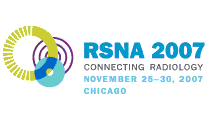
Abstract Archives of the RSNA, 2007
SSG19-05
Dual Source CT for Chest Pain Assessment
Scientific Papers
Presented on November 27, 2007
Presented as part of SSG19: ISP: Cardiac (CT)
Thorsten R.C. Johnson MD, Presenter: Speakers Bureau, Siemens AG
Konstantin Nikolaou MD, Abstract Co-Author: Nothing to Disclose
Alexander Becker MD, Abstract Co-Author: Nothing to Disclose
Carsten Rist MD, Abstract Co-Author: Nothing to Disclose
Maximilian F. Reiser MD, Abstract Co-Author: Nothing to Disclose
Christoph Richard F. Becker MD, Abstract Co-Author: Nothing to Disclose
Comprehensive CT angiography protocols offering a simultaneous evaluation of pulmonary embolism, coronary stenoses and aortic disease are gaining attractiveness with recent CT technology. The aim of this study was to assess the diagnostic accuracy of a specific Dual Source CT protocol for chest pain assessment.
109 patients suffering from acute chest pain were scanned on a Somatom Definition (Siemens, Forchheim, Germany) with a temporal resolution of 83 ms and 0.6 mm collimation using a body weight adapted contrast material injection regimen. Two readers evaluated the images for initial diagnosis. A third reader correlated the coronary findings to invasive coronary angiography in 29 patients, performed dose calculations and reviewed the files of patients with negative exams for further diagnoses.
There were technical limitations from insufficient contrast opacification in 6 and from breathing in 3 patients. Heart rates ranged from 58 to 124 bpm with a median of 72. The cause of chest pain was identified in 83 patients. Among the most frequent diagnoses were coronary stenoses, valvular and myocardial disease, pulmonary embolism, aortic aneurysm and dissection. Regarding a one-month follow-up as standard of reference, the overall sensitivity for the identification of the cause of chest pain was 98%. Correlation to invasive coronary angiography showed an high diagnostic accuracy in the patient-based evaluation with no non-diagnostic exams and 100% negative predictive value. In the segment based analysis only 7% of coronary artery segments were rated as non-assessable. Sensitivity, specificity, positive and negative predictive value amounted to 100%, 99%, 79% and 100%, respectively.
Dual Source CT offers a very high diagnostic accuracy in chest pain assessment, mainly due to the heart rate insensitivity of coronary CTA.
ECG gated DSCT angiography of the whole chest can be a helpful tool in the triage of chest pain patients.
Johnson, T,
Nikolaou, K,
Becker, A,
Rist, C,
Reiser, M,
Becker, C,
Dual Source CT for Chest Pain Assessment. Radiological Society of North America 2007 Scientific Assembly and Annual Meeting, November 25 - November 30, 2007 ,Chicago IL.
http://archive.rsna.org/2007/5002942.html

